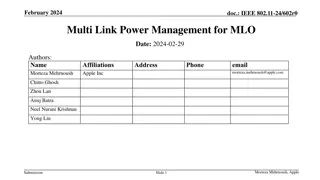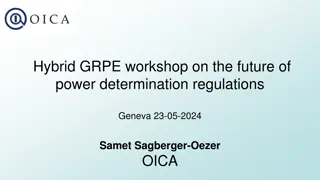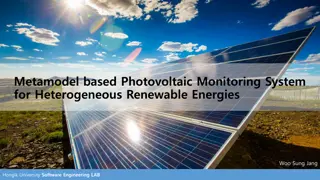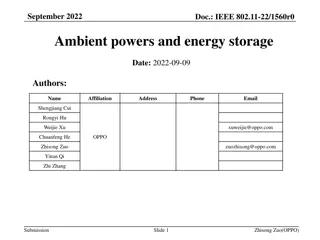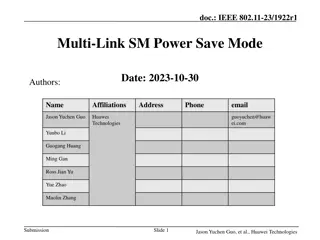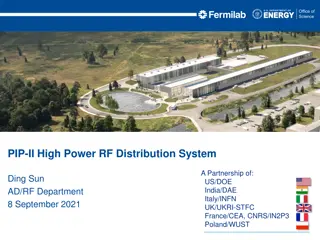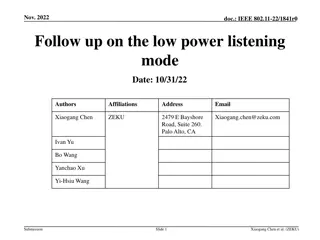
Pakistan Power Sector: Background, Present Situation & Future Plans
Explore the history, current status, and future outlook of Pakistan's power sector, from the formation of WAPDA in 1958 to the restructuring efforts in recent years. Understand the role of PEPCO, distribution networks, and consumer consumption patterns in shaping the country's energy landscape. Discover key insights into power generation, transmission, and the evolving energy sector in Pakistan.
Download Presentation

Please find below an Image/Link to download the presentation.
The content on the website is provided AS IS for your information and personal use only. It may not be sold, licensed, or shared on other websites without obtaining consent from the author. If you encounter any issues during the download, it is possible that the publisher has removed the file from their server.
You are allowed to download the files provided on this website for personal or commercial use, subject to the condition that they are used lawfully. All files are the property of their respective owners.
The content on the website is provided AS IS for your information and personal use only. It may not be sold, licensed, or shared on other websites without obtaining consent from the author.
E N D
Presentation Transcript
PAKISTAN POWER SECTOR BACK-GROUND, PRESENT SITUATION & FUTURE PLANS
POWER SECTOR - BACKGROUND WAPDA was formed in 1958. The major responsibilities of WAPDA were; Meet electricity demand of the country (except area of Karachi) by installing new power plants, transmission lines and distribution system. Develop hydro storage project ( dams) for meeting irrigation and demand of the country and install hydro plants at dams locations. 2
POWER SECTOR- BACKGROUND POWER SECTOR - BACKGROUND WAPDA Had Two Wings; 1. Power wing Responsible for power matters 2. Water wing Responsible for water matters The WAPDA AUTHORITY consisted of; Chairman Member Power- Head of Power wing Member Water Head of Water wing Member Finance Head of Financial matters 3
POWER SECTOR - BACKGROUND SECTIONS OF POWER WING WAPDA 1. Hydro Generation plants 2. Thermal Generation plants 3. Transmission lines and grid stations 4. Distribution network for consumers 4
POWER SECTOR - BACKGROUND 1. The GoP approved Pakistan Power Sector Strategic Plan for restructuring and reform in 1992. 2. PEPCO was established in 1998 as an independent entity with mandate to split Power wing of WAPDA into various entities and then corporatize & commercialize the restructured entities. 3. PEPCO initiated the restructuring and reform process in 1998. The reform process was considerably slowed down beyond 2001 when PEPCO was reduced to a Division in WAPDA. 4. The GoP reactivated the mandate of PEPCO in October 2007 to bridge the increasing demand supply gap and to reduce the resulting load shedding in the country 5. By the end of 2011, everybody was fed up with PEPCO, and now the restructured entities are being managed by the Ministry of Water & Power directly. 5
PEPCO SYSTEM 1. Hydro Generation 2. Thermal Generation 3. Transmission 4. Distribution (Remains with WAPDA) 4 GENCOs 1 NTDC 10 DISCOs 6
Consumers vs Consumption Pattern No. of Consumers (As on 30th Jun 2013) Consumption (Jul 2012 - Jun 2013) Consumers Category Billion units Nos. % age % age Domestic 18,713,537 85.55% 33.258 51.18 Commercial 2,550,808 11.66% 4.657 7.17 Industrial 296,849 1.36% 19.172 29.5 Agricultural 301,115 1.38% 7.548 11.61 Others 13,291 0.06% 0.351 0.54 Total 21,875,600 100.00% 64.986 100.00% 7
Consumption Pattern Jul-2012 - Jun 2013 Others 0.54% Agricultural 11.61% Domestic 51.18% Industrial 29.50% Commercial 7.17% 8
GENERATION SOURCES June 2013 1. HYDRO WAPDA IPPS Sub Total 2. THERMAL EX. WAPDA GENCOs IPPs NUCLEAR Sub-Total GRAND TOTAL 6733 195 6928 4785 8359 650 13794 20,722 9
Generation Sources (MW) June 2013 Thermal Nuclear, 650, 3.14% Hydro WAPDA, 6733, 32.49% Thermal IPPs, 8359, 40.34% Thermal Ex.WAPDA GENCOs, 4785, 23.09% Hydro IPPs, 195, 0.94% 10
EXISTING GENERATING CAPABILITY(June, 2013) Availability (MW) Nameplate/ Installed Capacity (MW) Dependable Capacity (MW) Type of Generation Summer Winter Hydro 6928 6928 6928 2300* GENCOs 4785 3536 2736 3178** IPPs (incl Nuclear) 9009 8300 7000 7578** Total 20722 18764 16664 13056 *Hydro availability based on last 5 years average ** Excludes 10% Forced Outages for GENCOs & 6.0% for IPPs 11
VARIATION IN GENERATION MIX YEAR HYDEL GENERATION THERMAL GENERATION 1994- 95 50 % 50 % (Mostly on gas) 2000- 01 30 % 70 % 2006- 07 36 % 64 % 2012- 13 34 % 66 % ( Mostly on oil) 12
Reasons For Price Hike Of Cost Of Electricity Oil Prices are beyond control of Pakistan Depletion of natural gas reserves Non-conducive circumstances for foreign investments (national/regional instability) Delay in exploitation of indigenous resources, i.e. Thar Coal in South and huge hydel potential in Northen Areas Theft of Electricity 13
PEPCO SYSTEM HISTORICAL SURPLUS / DEFICIT Available Capability 10894 10958 11834 12792 12600 13292 12442 13637 13445 13193 12320 13577 Computed Peak Demand 10459 11044 11598 12595 13847 15838 17398 17852 18467 18521 18940 18827 Surplus/ Shortfall 435 -86 236 197 -1247 -2546 -4956 -4215 -5022 -5328 -6620 -5250 Years 2001-02 2002-03 2003-04 2004-05 2005-06 2006-07 2007-08 2008-09 2009-10 2010-11 2011-12 2012-13 24/12/2010
Advance Caution Of Load Shedding/Short Fall By Planning Power WAPDA/NTDC In The Year 2000 25000 20000 Capability Forecast Capability (MW) 15000 10000 5000 0 1999-00 2000-01 2001-02 2002-03 2003-04 2004-05 Years 2005-06 2006-07 2007-08 2008-09 2009-10 15
Country wide Load Forecast of XWAPDA DISCOs & KESC (MW) Year 2011-12 2012-13 2013-14 2014-15 2015-16 2016-17 2017-18 2018-19 2019-20 2020-21 Note KESC 3021 3240 3484 3762 4157 4592 5067 5587 6144 6752 Country 22199 23407 24792 26261 27896 29647 31562 33604 35822 38127 XWAPDA DISCOs 19400 20401 21556 22761 24018 25352 26810 28353 30036 31757 Diversity Factor 1.01 is applied to get country demand NTDC demand is PMS based prepared in March 2012 KESC demand is Regression Based prepared in January 2011 16
Existing Transmission Network of NTDC 500/220 kV Transformers (14,850 MVA) 220/132 kV Transformers (18,044 MVA) 500 kV Lines (5,078 km) 220 kV Lines (7,947 km)
Long Term Transmission Expansion Plan The proposed transmission expansion plan upto 2030 will be able to transmit about 90,000 MW power. 19
Comprehensiveness OF Transmission Expansion Plan The Transmission Expansion Plan has been proposed to successfully and safely evacuate power from the mega hydel projects in the Northern areas and Thar Coal Power projects in the Southern part of the country. 20
Finances Required Huge Investment to the tune of about 280 Billion USD are required by 2030 for reliable Generation and Transmission Expansion to meet the Forecasted Electric Power Demand. Huge Investment to the tune of about 280 Billion USD are required by 2030 for reliable Generation and Transmission Expansion to meet the Forecasted Electric Power Demand. 21
Situation after June, 2013 The present government has some aggressive plans to install coal fired plants at Gadani Power Park and Bin Qasim Karachi to bridge the gap in supply and demand by the year 2017. The success in implementation of the plans, however depends on how much conducive environment is created for foreign investment. 22


